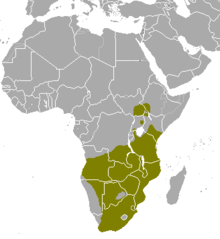
Back Eland Afrikaans ወንደቢ Amharic علند شائع Arabic ايلاند (نوع من الثدييات) ARZ Канна (хӀайван) AV Frempol (Taurotragus oryx) AVK Обикновена антилопа кана Bulgarian Antilopenn-eland Breton Eland Catalan Taurotragus oryx CEB
| Common eland | |
|---|---|

| |
| Scientific classification | |
| Domain: | Eukaryota |
| Kingdom: | Animalia |
| Phylum: | Chordata |
| Class: | Mammalia |
| Order: | Artiodactyla |
| Family: | Bovidae |
| Subfamily: | Bovinae |
| Genus: | Taurotragus |
| Species: | T. oryx
|
| Binomial name | |
| Taurotragus oryx (Pallas, 1766)
| |
| Subspecies | |
| |

| |
| Common eland range | |
| Synonyms | |
|
Species synonymy[2]
| |

The common eland (Taurotragus oryx), also known as the southern eland or eland antelope, is a large-sized savannah and plains antelope found in East and Southern Africa. An adult male is around 1.6 m (5.2 ft) tall at the shoulder (females are 20 cm (7.9 in) shorter) and can weigh up to 942 kg (2,077 lb) with a typical range of 500–600 kg (1,100–1,300 lb), 340–445 kg (750–981 lb) for females).
It is the second-largest antelope in the world, being slightly smaller on average than the giant eland.[3] It was scientifically described by Peter Simon Pallas in 1766.
Mainly a herbivore, its diet is primarily grasses and leaves. Common elands form herds of up to 500 animals, but are not territorial. The common eland prefers habitats with a wide variety of flowering plants such as savannah, woodlands, and open and montane grasslands; it avoids dense forests. It uses loud barks, visual and postural movements, and the flehmen response to communicate and warn others of danger. The common eland is used by humans for leather, and meat and has been domesticated in southern Africa. Eland milk contains more butterfat than cow's milk, and can keep longer without pasteurising.[citation needed]
It is native to Angola, Botswana, the Democratic Republic of the Congo, Eswatini, Ethiopia, Kenya, Lesotho, Malawi, Mozambique, Namibia, Rwanda, South Africa, South Sudan, Tanzania, Uganda, Zambia, and Zimbabwe, but is no longer present in Burundi. While the common eland's population is decreasing, it is classified as of least concern by the International Union for Conservation of Nature.
- ^ IUCN SSC Antelope Specialist Group (2008). "Tragelaphus oryx". IUCN Red List of Threatened Species. 2008. Retrieved 21 November 2011.
- ^ Cite error: The named reference
wilsonwas invoked but never defined (see the help page). - ^ Pappas, LA; Elaine Anderson; Lui Marnelli; Virginia Hayssen (5 July 2002). "Taurotragus oryx" (PDF). Mammalian Species. 689: 1–5. doi:10.1644/1545-1410(2002)689<0001:TO>2.0.CO;2. S2CID 198968884. Archived from the original (PDF) on 23 December 2011.
© MMXXIII Rich X Search. We shall prevail. All rights reserved. Rich X Search
